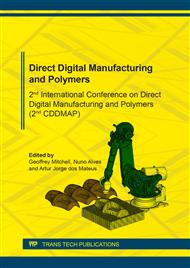[1]
K.V. Wong , A. Hernandez, A Review of Additive Manufacturing, ISRN Mechanical Engineering 2012 (2012) 1-10.
Google Scholar
[2]
G. Mittal, V. Dhand, K.Y. Rhee, S.-J. Park , W.R. Lee, A review on carbon nanotubes and graphene as fillers in reinforced polymer nanocomposites, Journal of Industrial and Engineering Chemistry 21 (2015) 11-25.
DOI: 10.1016/j.jiec.2014.03.022
Google Scholar
[3]
M. Etcheverry , S.E. Barbosa, Glass Fiber Reinforced Polypropylene Mechanical Properties Enhancement by Adhesion Improvement, Materials (Basel) 5 (2012) 1084-1113.
DOI: 10.3390/ma5061084
Google Scholar
[4]
W.-I. Park, M. Kang, H.-S. Kim , H.-J. Jin, Electrospinning of Poly(ethylene oxide) with Bacterial Cellulose Whiskers, Macromolecular Symposia 249-250 (2007) 289-294.
DOI: 10.1002/masy.200750347
Google Scholar
[5]
K. Iakoubovskii, Techniques of aligning carbon nanotubes, Open Physics 7 (2009).
Google Scholar
[6]
G.R. Mitchell, Electrospinning: principles, practice and possibilities, ed., (2015).
Google Scholar
[7]
D.K. Shinde , A.D. Kelkar, Effect of TEOS electrospun nanofiber modified resin on interlaminar shear strength of glass fiber/epoxy composite, World Acad. Sci. Eng. Technol. Int. J. Mater. Metall. Eng 1 (2014).
Google Scholar
[8]
M. Nazhipkyzy, S.D. Mohan, F.J. Davis , G.R. Mitchell, Carbon nanotubes in electrospun polyethylene oxide nanofibres: A potential route to conducting nanofibres, Journal of Physics: Conference Series 646 (2015) 012007.
DOI: 10.1088/1742-6596/646/1/012007
Google Scholar
[9]
P. Bartolo , G. Mitchell, Stereo-thermal-lithography: a new principle for rapid prototyping, Rapid Prototyping Journal 9 (2003) 150-156.
DOI: 10.1108/13552540310477454
Google Scholar
[10]
C. Sun, N. Fang, D. Wu , X. Zhang, Projection micro-stereolithography using digital micro-mirror dynamic mask, Sensors and Actuators A: Physical 121 (2005) 113-120.
DOI: 10.1016/j.sna.2004.12.011
Google Scholar
[11]
H. Liao, Y. Wu, M. Wu, X. Zhan , H. Liu, Aligned electrospun cellulose fibers reinforced epoxy resin composite films with high visible light transmittance, Cellulose 19 (2012) 111-119.
DOI: 10.1007/s10570-011-9604-1
Google Scholar
[12]
H. Fong, Electrospun nylon 6 nanofiber reinforced BIS-GMA/TEGDMA dental restorative composite resins, Polymer 45 (2004) 2427-2432.
DOI: 10.1016/j.polymer.2004.01.067
Google Scholar
[13]
T. Guo, Z. Zhou, H. Guo, G. Xiao, X. Tang , M. Peng, Toughening of epoxy resin with functionalized core‐sheath structured PAN/SBS electrospun fibers, Journal of Applied Polymer Science 131 (2014).
DOI: 10.1002/app.41119
Google Scholar
[14]
C. Miao, W.Y. Hamad, Cellulose reinforced polymer composites and nanocomposites: a critical review, Cellulose 20 (2013) 2221-2262.
DOI: 10.1007/s10570-013-0007-3
Google Scholar



